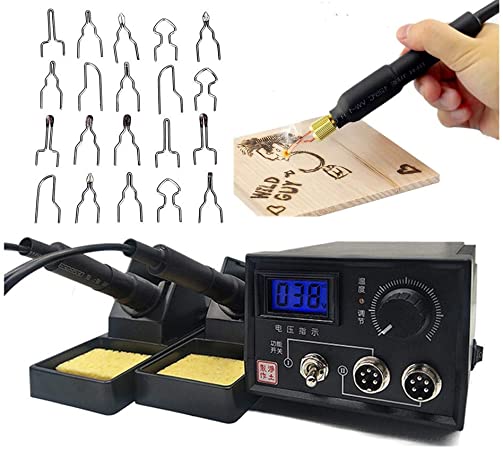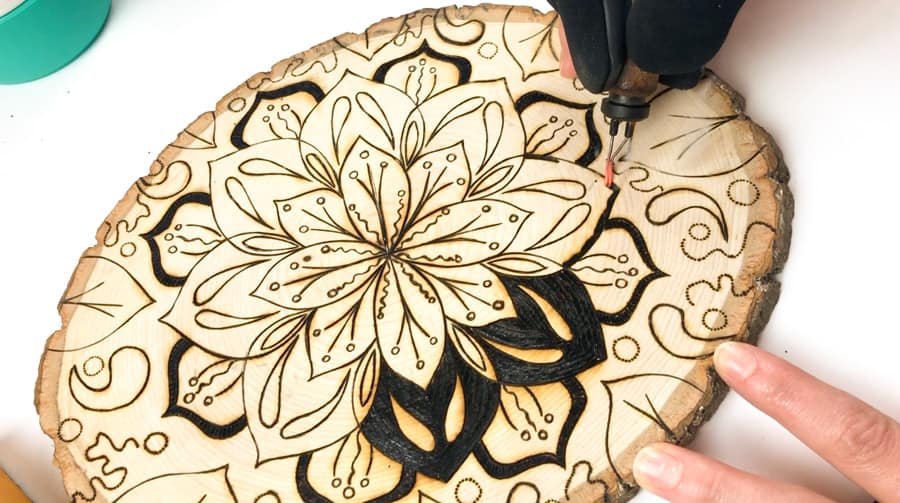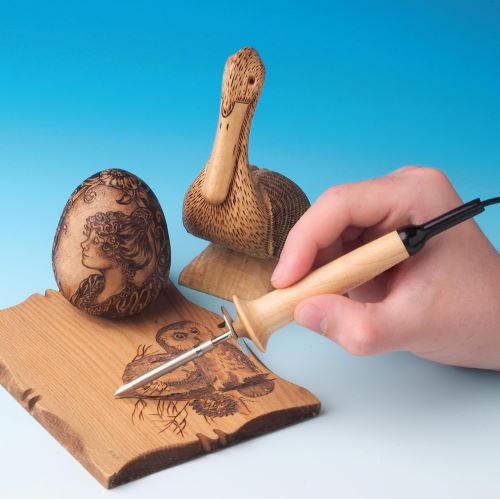
It is important not to press down too hard on your pyrography tool when wood burning. It is important to avoid MDF and pressure-treated wood. Depending on the wood you're burning, you can use a variety of tools to finish the project. These are some helpful tips to get you started. In no time, you'll be able build beautiful wood burning projects. And remember, these tips are for everyone, not just professionals!
Your pyrography tool should not be used to force you too hard
Wood burning can be difficult to master. A good pyrography set will help you get started. You should also purchase a wood burning tool that you can use to write your letters. Wood burning letter nibs are available in many styles, including freehand writing. A stencil design can make it much easier than wood burning nibs.
Keep your pyrography tools on a stand to prevent injuries to your hands. Do not place your tool directly on the wood you are burning. It can cause the tip and other parts to heat up. Flat-nose pliers can be used to add or remove wood burning bits. A bowl of water is always handy for wood burning. It is important to ensure that your surface is stable before starting. If you are using treated wood, ensure it isn’t flammable.
You should try wood burning on scrap wood before you attempt to burn a piece of wood. Make sure to turn the wood so that it is at the right angle to be burned. Before you begin burning, make sure to clean the points with 320-grit sandpaper. This will ensure even heat flow and avoid any burn marks. Next, use outlining techniques to begin your design. These will help you to make your design stand out and define its shape. Detailed areas are what give your image texture.
Avoid pressure-treated wood
For several reasons, it is best to avoid pressure-treated timber if you are looking to build a woodfire. Preservatives in pressure-treated wood can leach into groundwater. They can have negative effects on the human body. They can also pollute the atmosphere. The best solution is to seal wood treated with pressure. Sealing pressure-treated wood will improve its durability and stop preservatives from leaching.

The chemicals in pressure-treated lumber release toxic fumes and pollutants to the air when they are burned. Many of these chemicals can end up in your lungs, which can lead to serious health issues. Both the EPA (and Consumer Product Safety Commission) have cited reports indicating that pressure-treated wooden is hazardous. The body is extremely sensitive to chromated copper-arsenate wood (CCA). The EPA has limited the use of CCA-treated wood in commercial construction.
When buying pressure-treated lumber, look for the splits on the wood's surface. These splits, which are typically half an inch long, indicate that chemicals were used under pressure. The preservatives in pressure-treated lumber make it less prone to decay and insect infestation. This type of wood is also more resistant to fire, moisture, and UV rays. It doesn't really matter whether the wood was pressure-treated or untreated. However, it is essential to make the best choice for your wood-burning project.
Avoid MDF
MDF looks fantastic, but wood that contains it should not be burned. MDF glue can be harmful to inhale, if it is released during burning. UFs are toxic fumes emitted by wood-burning devices. Once they are released into the environment, they inhale in the air and can cause severe health problems. UFs can cause allergic reactions, eye irritation, and even cancer if the concentration is high enough.

MDF can be used in wood-burning projects, but you should always read the label. The chemicals and other compounds in pressure-treated wood can cause harm to your health. MDF and plywood both are made from three layers, which have been bonded together. The outer layers must be exposed in order to burn MDF. You can keep MDF-free material clean by using a paper towel.
Wood burning is best done before using any wood. This includes hardwood and plywood as well fiberboard. Certain types of wood are more volatile than others. To avoid breathing in the fumes and dust created by the burning process, a respirator is recommended. If necessary, you should ventilate the work area and open all doors.
FAQ
What else should I know about woodworking in general?
It is easy to underestimate how much work it takes to make furniture. The hardest part of the process is actually finding the right wood. There are so many wood options that it can be difficult to choose the right one.
Another problem is that not all wood has uniform properties. Woods can warp, split, or crack over time. You must take these things into consideration before purchasing wood.
How do I calculate woodworking prices
It is crucial to keep project costs as low-cost as possible. It is important to ensure that you are getting the best materials prices. It is also important to consider the costs of other factors, such time, skill, and experience. Our guide to the average household DIY task price will give you an idea of how much it costs to complete different types of woodwork projects.
How much does a hobbyist need to invest in getting started?
If you're looking to start your own woodworking business, you'll probably need some capital to buy the necessary tools and supplies. The best place to start is by buying a small drill press, circularsaw, circular saw or sanding machine. These items aren’t too expensive so you won’t have to break the bank.
Which woods are good to use for furniture-making?
Woods can be classified according to how hard they are. Softwoods include pine, fir, cedar, and cypress. Because they are resistant to rot, softwoods are often used as outdoor furniture. The hardwoods are oak, maple and mahogany. They're generally used indoors because they won't weather well outdoors.
Do I have to refinish my furniture?
Yes! There are many options for refinishing furniture that you don't need to hire a professional. Here are some examples:
Use sandpaper on the surface to remove any stains or scratches. Then wipe down the surface with a clean cloth.
Apply clear polyurethane paint. Allow to dry thoroughly before moving furniture.
Acrylic paint is a great way to paint furniture.
Instead of using paint, stain is a better choice. The furniture will have a rich look thanks to the stain.
Shellac wax can be applied. Wax will protect the wood and add shine.
What is the difference between a hobbyist or a professional woodworker, and how can you tell?
Hobbyists enjoy making things out of wood, whereas professionals focus more on the quality of their work. Hobbyists often take pride in the creations they make and often share them to family and friends. Professionals spend hours researching design ideas before starting to work on a project. They'll pay great attention to details, from choosing the most suitable materials to finishing the work perfectly.
How do you know which type of wood you are working with?
Always verify the label on wood purchases. The label should include information about the wood species and its moisture content as well as whether or not it has been treated using preservatives.
Statistics
- The U.S. Bureau of Labor Statistics (BLS) estimates that the number of jobs for woodworkers will decline by 4% between 2019 and 2029. (indeed.com)
- Woodworkers on the lower end of that spectrum, the bottom 10% to be exact, make roughly $24,000 a year, while the top 10% makes $108,000. (zippia.com)
- Average lumber prices rose about 600 percent between April 2020 and May 2021. (familyhandyman.com)
- Overall employment of woodworkers is projected to grow 8 percent from 2020 to 2030, about as fast as the average for all occupations. (bls.gov)
External Links
How To
How to stain wood
Staining wood refers to applying chemicals to wood's surface. This chemical reaction causes the wood to change in color. This chemical reaction causes the wood color to change from white and brownish red. Oak is the most common wood type for staining. However, you can also use other wood types.
There are many methods to apply stain to wood surfaces. Some methods include mixing the stain along with a solvent like turpentine and then applying the mixture to the wood by brushing or spraying. Others use a solution made up of water and dye, which is then applied directly onto the wood. You can mix stains into varnishes or paints to make them part of your finish coat.
The first step in staining wood is preparing the surface. Cleaning the wood thoroughly removes any dirt or grease that could interfere with applying the stain. Sanding smoothens scratches and rough spots. You must then decide on the type of stain that you wish to use. There are two main kinds of stains available: non-penetrating stains and penetrating. Penetrating stains penetrate deeper into the wood than non-penetrating ones, making them ideal for dark colors such as mahogany. The best non-penetrating colors are those that work with light colors like maple.
After choosing the type and application method you prefer, gather your tools. You can use a paintbrush to apply stains. This allows you spread the liquid evenly over the surface. It is a good idea to have rags on hand in case you need them to clean up any stains that may remain after you have finished painting. If you plan to mix the stain yourself, make sure you have enough containers available to hold the different components of the mixture.
After you have prepared your materials for staining, clean the area. Use warm water and soap to clean away dirt and dust. Use a dampened rag and clean water to wipe the furniture. If you intend to stain darker wood, make sure you get rid of any debris.
Apply the stain next. Next, apply the stain to the furniture by starting at one end. Work slowly and carefully, moving back and forth along the grain of the wood until you reach the opposite end. Be careful not to let the stain drip off the wood's edge. Allow the stain to dry completely before you move on to the next step.
Clear polyurethane is used to protect the painted surfaces. Apply three coats with polyurethane. Allow the third coat of polyurethane sealer to dry overnight before applying the final coat.